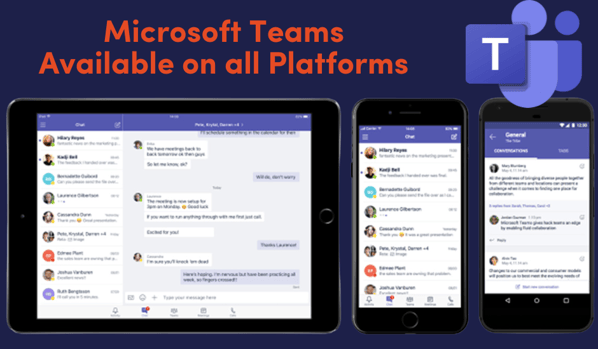Effective communication is the cornerstone of success, especially for small to mid-sized businesses (SMBs) looking to grow and compete. A part of the apps available within Microsoft 365, Microsoft Teams emerges as a powerful ally, offering a suite of features that go beyond mere texting to foster collaboration, integration, and efficiency.
Microsoft Teams is not just a platform; it’s a productivity powerhouse. For instance, consider a marketing team working on a new product launch. They can create a dedicated channel within Teams where all relevant files, from design mockups to press releases, are shared and discussed. The integration with SharePoint means that large files can be stored and accessed easily without clogging up email inboxes.
In this scenario, the threaded chat feature becomes invaluable. When the designer updates a mockup, they can post it in the thread, and feedback from the team is organized and easy to follow. If the project manager is traveling and offline, they can still catch up on all the discussions thanks to persistent chat history and contribute their insights when they’re back online.
Private chats are equally beneficial. Say a sales representative needs to discuss a sensitive client issue with their manager. They can do so in a private chat, ensuring confidentiality while still having the full context available for future reference.
The flexibility of Teams extends to its structure as well. A public team could be used for company-wide initiatives, like a wellness program, where all employees are encouraged to participate and share their experiences. On the other hand, a private team might be set up for a cross-departmental project, such as a new IT system implementation, where membership is carefully managed to include only those directly involved.
Moreover, Teams’ capabilities are enhanced by its compatibility with other Microsoft Office tools. For example, an HR department can use Forms to collect employee feedback, and then analyze the results in Excel, all within the Teams environment. This seamless integration streamlines workflows and keeps everything in one place, reducing the need to switch between applications.
Microsoft Teams is designed to adapt to various real-world business scenarios, providing a comprehensive suite of tools that facilitate communication, collaboration, and efficient project management.
Seamless Integration with Microsoft Products
Microsoft Teams is not just a standalone product; it’s part of the broader Microsoft 365 ecosystem. This integration means that Teams works harmoniously with familiar tools like Word, Excel, PowerPoint, and OneNote. Users can collaborate on documents in real-time, schedule meetings through Outlook, and even utilize the robust analytics of Power BI, all within the Teams platform.
More Than Just Texting
While instant messaging is a core feature, Teams offers much more. Video conferencing, audio calls, and the ability to host live events provide a comprehensive communication solution. Teams channels can be customized for various projects, departments, or topics, ensuring that conversations are organized and focused.
.png?width=622&height=350&name=Editing%20%26%20Collaborative%20Spaces%20(15).png)
Centralized File Repository
Teams acts as a centralized hub for all your files, thanks to its deep integration with SharePoint and OneDrive. Files shared in conversations are automatically stored in a dedicated folder, making them easily accessible and searchable. This eliminates the need for multiple versions and the confusion that comes with them.
You know how you always have that one coworker who keeps asking you for the lastest version of a file you have sent them three times? Drop the link to the file in your Teams chat and it gets stored in the “Files” section of the chat. They will probably keep asking you where that file is. But now, at least, you can simply remind them they already have it in the chat. You know, the chat you are talking in right now.
Meetings with groups of people have this feature as well, so the files you shared on your screen with your team can be shared in that meeting’s chat for referencing and collaboration.
Soft Phone System Capabilities
With Teams Phone, SMBs can have a full-fledged phone system that allows for making and receiving calls, call forwarding, voicemail, and even audio conferencing. This cloud-based telephony solution reduces the need for traditional phone hardware and streamlines communication channels.
User-Friendly for All Sizes
One of the most significant advantages of Teams is its ease of use. The interface is intuitive, making it simple for teams of any size to adopt and use effectively. Whether you’re a startup or a growing enterprise, Teams scales to meet your needs without compromising on functionality or user experience. And it is available on all platforms.

Standing Above the Competition
When compared to its competitors, Teams stands out for its deep integration with Office apps, comprehensive communication tools, and robust security features. It’s a unified platform that supports the diverse needs of SMBs in a way that other solutions simply can’t match.
In conclusion, Microsoft Teams is more than just a communication tool; it’s a comprehensive platform that empowers SMBs to operate more effectively and efficiently. By leveraging the power of Teams, businesses can enjoy streamlined workflows, enhanced collaboration, and a competitive edge in the market.